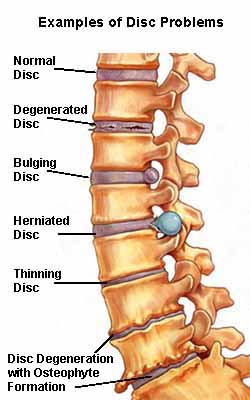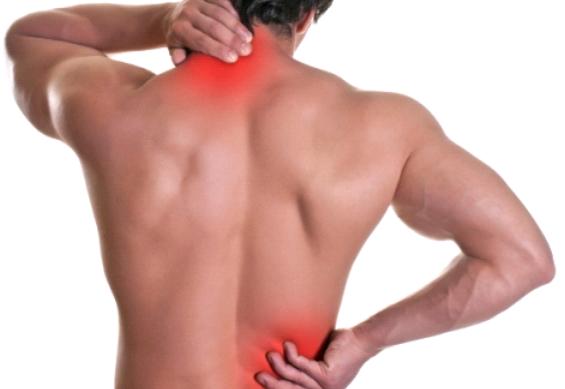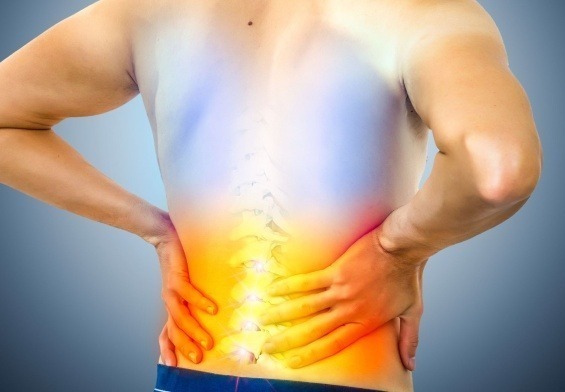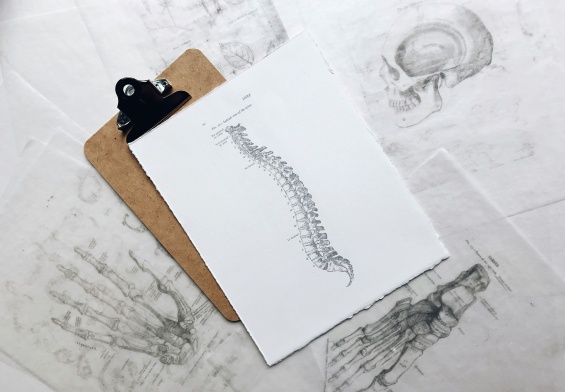Medical experts rank back pain as one of most common medical conditions, affecting an estimated 80% of all Americans at some point during their lives. What makes back pain particularly troublesome, is that it is a medical condition that affects people of all ages, genders, and ethnic backgrounds. But what exactly causes back pain?
An adult spine consists of a stack of 24 bones called vertebrae, plus the bones of the sacrum and coccyx. These bones support the human body and protect the spinal cord’s major column of nerve fibers connected to the brain. These fibers run through the vertebrae via the spinal canal. Between each vertebra are discs made of cartilage and filled with a gel-like material, these act similar to a shock absorber. Also, ligaments, muscles, tendons and small joints called facets help hold the vertebrae together.
What people fail to understand is that back pain is a symptom, not a cause. Therefore, there is no single answer to the cause of back pain because each case differs depending on the patient. To complicate matters even further, the pain may not always be from your back, even if it feels like that’s where the pain originates. In fact, back pain may likely stem from a completely different area in the body. With that being said, a variety of physical and mental conditions can affect a person’s spine, resulting in pain radiating throughout the entire spine. But what are these spine conditions and, more importantly, how can a spine doctor rectify symptoms to alleviate back pain and discomfort?
Proactively Improving Poor Posture
Many people cannot comprehend the extent of how poor posture can greatly induce back pain. Individuals can help alleviate – or even prevent – back pain by making strives to improve postural awareness, as well as making small modifications in their day-to-day movements. Correct sitting and standing postures go hand-in-hand – doctors advise to keep head and shoulders erect and balanced, as well as stand up straight and look straight ahead. Try to avoid sitting or standing for long periods of time while at work. Instead, be sure to take periodic rest breaks and change positions as needed. Finally, always position oneself close to a desk and work at a comfortable height.
Mental Health Issues
Mental health issues such as stress can exacerbate back pain. When stressed, the muscles within the back tighten. With enough stress and enough tightening, one will eventually begin to experience moderate to severe pain. In the same manner, other mental health issues such as depression, anxiety, sleep deprivation or insomnia can result in further back pain.
Dietary Problems
This may be hard to believe, but stomach pain from an unhealthy diet can also trigger back pain because the muscles of the stomach and back interconnect. Problems that affect the stomach – a poor diet, over-consumption of alcohol, convulsive nausea – can result in back pain. A 2014 study found that approximately 31% of women and 25% of men experiencing back pain reported gastrointestinal issues such as abdominal pain or food intolerance. The link between nutrition and back pain stems from inflammation; foods high in fat and sugar trigger inflammation throughout the body, including the lower back.
Furthermore, back pain may be due to dehydration. The bones in the spine have discs between them, each partly made up of a jelly-like substance that is 90% water. The human body needs a steady stream of fluid coming in to help keep that cushioning intact. When the body becomes dehydrated, those discs become flatter and less cushiony, which can induce back pain.
A Pinched Nerve
A pinched nerve occurs when the surrounding bone, muscle, cartilage or other tissue puts pressure on a nerve. The spine, with its complex skeletal structure, can make locating the source of the pain somewhat difficult because certain nerves extend throughout the body. For instance, the nerves from the neck extend all the way to the fingertips. Depending on the exact nerve, as well as the extent of the pressure, a pinched nerve can cause a myriad of symptoms including mild to severe discomfort, shooting pains, tingling, muscle weakness, and atrophy or withering of affected muscles. In more severe cases, a pinched nerve in the back can result in a loss of motor control and reflexes in the hands.
Patients can avoid pinched nerves by striving to maintain good posture, remaining fit and at a reasonable weight, and avoid excessive strain on the back. Treatment options for pinched nerves include physical therapy, rest, and medication to relax the muscle and reduce inflammation. In more severe cases, a spine specialist may suggest surgery as a last resort.

A Herniated Disc
Back pain may also be a result of a herniated disc. A herniated disc occurs when a disc protrusion ruptures or herniates through the wall of the intervertebral disc. When this happens, viscous material from the interior of the disc leaks into the spinal canal, where it can impinge on nerves and cause pain and other problems, including partial paralysis. Disc herniations typically happen two stages. The first stage occurs when the disc’s interior material pushes into the thick outer wall, thereby creating a bulge. The second stage of the process transpires when the bulge becomes larger. During this stage, spine experts classify it as a disc protrusion. If the protrusion continues to expand, it can eventually become a herniated, or ruptured disc.
Degenerative Disc Disease
Degenerative disc disease is one of the most common spinal conditions that people face. In most cases, this occurrence is actually part of the normal aging process. Degenerative disc disease arises from the deterioration and structural change of the cushioning intervertebral discs located between individual vertebrae throughout the spine. Over time, the discs weaken and become more fragile from wear and tear caused by a lifetime of twisting and turning. In addition to age, genetics may also play a role in causing degenerative disc disease. Furthermore, other causes of degenerative disc disease include trauma, repetitive stress, and disease.
Degenerative disc disease can affect any part of the spine; therefore spinal experts classify the condition by its location. Lumbar degenerative disc disease refers to disc degeneration in the lower back. This is one of the most common causes of lower back pain, which is sometimes referred to as lumbago. Meanwhile, cervical degenerative disc disease refers to degenerative disc disease located in the neck. Degeneration of the disc tissue also makes the disc more susceptible to herniations, or rupturing of the discs. Symptoms of degenerative disc disease include pain and restricted range of motion.
While aging is a natural and unavoidable process, individuals can still take steps to minimize the onset and impact of degenerative disc disease. Individuals can help lower their risk of experiencing degenerative disc disease by maintaining a healthy weight, exercising regularly, having a nutritious and balanced diet, quitting smoking, and avoiding activities that have a high risk of resulting in back and neck injuries.
Without intervention, degenerative disc disease will progress by ultimately involving the spinal joints, called facet joints. But what exactly should one do if the spinal discs already exhibit deterioration? In mild cases, specific exercises for degenerative disc disease may help solve this issue. Historically, other treatment options range from the use of medications to surgery in some severe cases. Today, many spine specialists offer minimally invasive alternative treatment options such as lumbar disc replacement.
Spinal Stenosis
In spinal stenosis, the spinal canal narrows, and puts pressure on the nerves branching out from the spine, and sometimes on the spinal cord itself, causing pain, tingling, numbness, and weakness in the extremities. Spinal stenosis occurs predominantly in two locations of the spine and thereby classified by the location. For example, lumbar spinal stenosis occurs in the lumbar or lower region of the back, and cervical spinal stenosis affects the cervical or neck region.
The structures that contribute to and cause spinal stenosis include the discs between the vertebrae, the facet joints, and the ligaments, which help to connect the vertebrae to each other. The narrowing of the spinal canal may result from abnormal bone or tissue growth. Most cases of spinal stenosis develop slowly over many years due to the normal aging process and generalized wear and tear of the spine. Some causes of acquired spinal stenosis include osteoarthritis, bone spurs, herniated discs, spondylolisthesis, trauma to the spine, and normal aging. There is also a less common hereditary form of spinal stenosis in which the diameter of the spinal canal is unnaturally small from birth. By living a healthy lifestyle with proper exercise, good nutrition, and maintaining proper weight, individuals can help prevent symptoms of spinal stenosis from occurring.
For those affected by this condition, spinal stenosis treatment options include physical therapy, spinal stenosis exercises, medications, and lumbar steroid injections. In cases that fail to improve with these treatment measures, and experienced spine surgeon may suggest surgery to correct the condition.
When To Seek Out A Spine Specialist For Back Pain
When someone continuously experiences back pain – whether chronic back pain or sudden severe pain – they may wonder when they should seek help. In some cases, people knowingly prolong their suffering due to fear and anxiety about possible surgery. While fear may be a normal response to any health issue, avoiding the underlying issue can actually increase the chances that a person will need to undergo spinal surgery.
 Most often, back pain severity will help tell a person when it is time to consult a doctor for relief. But there are also other situations when a person should consider seeing a spinal physician such as:
Most often, back pain severity will help tell a person when it is time to consult a doctor for relief. But there are also other situations when a person should consider seeing a spinal physician such as:
- A High Fever: A fever unexplained by illness, when paired with back pain, may be a sign of a possible infection within the bones or disks of the spine. While this is relatively uncommon, it is still better to be safe than sorry.
- Trauma: If a person experiences back pain after an accident or fall, they should seek a proper assessment from a spine specialist. Continuing normal activities without receiving a full evaluation and appropriate treatment can result in further damage or a prolonged recovery period.
- Numbness or Weakness: Experiencing numbness or weakness anywhere in the body may actually be a sign of nerve irritation or damage. In addition, it can be a sign of more significant irritation of the nerve rather than having just pain alone. If numbness or weakness does not disappear in a short period of time, it is best to see a spine specialist for an evaluation to lessen the risk of long lasting or permanent nerve damage.
- Unexplained Weight Loss: Anytime a person loses weight unexpectedly and dramatically, it could be a harbinger of a more serious medical issue. When paired with back pain, a doctor will want to rule out infection or tumors as a possible cause for back pain and weight loss.
- Prolonged Back Pain: Most medical experts agree that 90% of back pain cases improve within six weeks. But if your pain remains unchanged or worsens, it is time to call a spine specialist to determine the underlying causes. If back pain causes an individual to wake you up in the middle of the night, this can be a sign of a problem beyond just normal back pain.
Don’t Suffer In Silence
A wide spectrum of conditions can cause back pain. Identifiable spinal conditions such as disc herniations, scoliosis, spinal stenosis and spinal cord injuries may be the most common, but they are far from the only causes of back pain. For the most effective diagnosis and treatment of back pain, seek a consultation with a spine expert immediately
Do not avoid seeking medical care when experiencing back pain. Only by receiving a proper diagnosis can a patient take steps towards an optimal recovery. In addition, medical care will also decrease the risk of further damage or injury to one’s back. When experiencing back pain without these symptoms, one should seek medical help when the symptoms and pain begin to negatively affect day-to-day activities.




